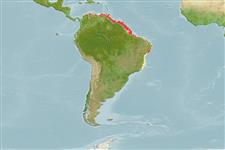Teleostei (teleosts) >
Siluriformes (Catfishes) >
Ariidae (Sea catfishes) > Bagreinae
Etymology: Bagre: Mozarabic, bagre, taken from Greek, pagros = a fish (Dentex sp.) (Ref. 45335).
More on author: Linnaeus.
Issue
Junior synonym Felichthys filamentosu is a valid species according to Marceniuk et al., 2023 (Ref. 130933:433).
Environment: milieu / climate zone / depth range / distribution range
Ecology
Marine; brackish; demersal; depth range ? - 50 m (Ref. 5217). Tropical; 12°N - 21°S, 77°W - 34°W
South America: Colombia to the mouth of the Amazon River.
Size / Weight / Age
Maturity: Lm ? range ? - ? cm
Max length : 55.0 cm TL male/unsexed; (Ref. 5217); common length : 40.0 cm TL male/unsexed; (Ref. 3265); max. published weight: 975.00 g (Ref. 125970)
Two pairs of barbels on rostral region, one pair on lower jaw, one pair on posterior end of maxilla; end of maxilla barbel beyond anal fin origin; pectoral spine filament long, reaching anal fin origin; dorsal, pectoral, and pelvic fin membranes black; anal fin membrane black distally (some individuals white), white proximally; body silver gray or blue gray dorsally, silver white ventrally (Ref. 13608).
Chiefly marine, common around river mouths and also entering river estuaries. Feeds on small fishes and invertebrates, such as crustaceans. Marketed fresh.
Life cycle and mating behavior
Maturities | Reproduction | Spawnings | Egg(s) | Fecundities | Larvae
Taylor, W.R. and N.A. Menezes, 1978. Ariidae. In W. Fischer (ed.) FAO species identification sheets for fishery purposes. West Atlantic (Fishing Area 31). volume 1. [pag. var.]. FAO, Rome. (Ref. 3265)
IUCN Red List Status (Ref. 130435)
Threat to humans
Traumatogenic (Ref. 36613)
Human uses
Fisheries: commercial
Tools
Special reports
Download XML
Internet sources
Estimates based on models
Preferred temperature (Ref.
123201): 26.9 - 28.2, mean 27.5 °C (based on 116 cells).
Phylogenetic diversity index (Ref.
82804): PD
50 = 0.5625 [Uniqueness, from 0.5 = low to 2.0 = high].
Bayesian length-weight: a=0.00468 (0.00354 - 0.00619), b=3.08 (3.00 - 3.16), in cm total length, based on LWR estimates for this species (Ref.
93245).
Trophic level (Ref.
69278): 4.0 ±0.66 se; based on food items.
Generation time: 6.9 ( na - na) years. Estimated as median ln(3)/K based on 1
growth studies.
Resilience (Ref.
120179): Low, minimum population doubling time 4.5 - 14 years (Preliminary K or Fecundity.).
Prior r = 0.57, 95% CL = 0.37 - 0.85, Based on 4 data-limited stock assessments.
Fishing Vulnerability (Ref.
59153): Moderate vulnerability (42 of 100).
Nutrients (Ref.
124155): Calcium = 106 [57, 219] mg/100g; Iron = 0.914 [0.586, 1.493] mg/100g; Protein = 17 [15, 19] %; Omega3 = 0.175 [0.100, 0.301] g/100g; Selenium = 57.3 [30.7, 116.6] μg/100g; VitaminA = 21.3 [9.5, 48.1] μg/100g; Zinc = 1.21 [0.83, 1.82] mg/100g (wet weight);
